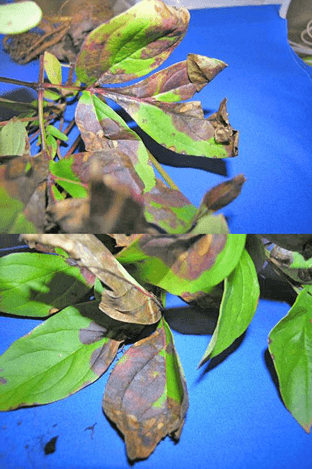Disease Notes
Contact
Plant Diagnostician
Phone: (479) 575-2727
Email: ssmith@uada.edu
Jason Pavel
Diagnostician
Phone: (479) 575-7257
Email: jpavel@uada.edu
University of Arkansas System Division of Agriculture
Cralley Warren Building
Room 16
2601 N. Young Ave.
Fayetteville, AR 72704
Peony
by Sherrie Smith and Jason Pavel

Peony Blotch-Graphiopsis chlorocephala, formerly Cladosporium paeoniae
Photo by Sherrie Smith, University of Arkansas Cooperative Extension
Peonies are up and have buds. They are one of our finest perennials. They are exceptionally long-lived, reaching ages of 50 years or more. They are also very healthy when planted with a minimum of 6 hours of sun in good garden soil with excellent drainage. Perhaps the most common disease we find on peonies is Red Spot (Blotch), caused by Graphiopsis chlorocephala, formerly Cladosporium paeoniae.
This looks ugly but does not significantly damage the plant. Symptoms begin as small, circular, red to purple spots on the upper surface of young leaves. These spots become a burnished dark purple. The undersides of the leaves become a chestnut brown color. Later in the season, the lesions coalesce, becoming large, irregular purple blotches. Susceptibility to Red Spot is quite variable, with many older cultivars being the most susceptible.
It is important to clean up peony debris. In the fall, prune all spent top growth to ground level, and remove it from the garden. Begin spraying on a weekly schedule when new growth is just breaking the soil in the spring, continuing until the flowers begin to open. Fungicides containing mancozeb, thiophanate-methyl, or copper are effective.
Take Aways
- Clean up all old foliage (critical).
- Avoid overhead irrigation.
- Begin fungicides when new growth first appears.
This work is supported by the Crop Protection and Pest Management Program [grant no. 2017-70006- 27279/project accession no. 1013890] from the USDA National Institute of Food and Agriculture.